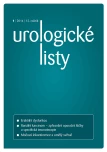Quality Improvement in Surgery
Authors:
Mark T. Edney
Authors‘ workplace:
American Urological Association Health Policy Council
American Urological Association Legislative Affairs Committee
; American Urological Association Gallagher Health Policy Scholar 2012–
2013
Published in:
Urol List 2014; 12(1): 29-31
Overview
In 2013, most developed countries are experiencing significant financial pressure to reduce debt and reign in spending. As healthcare is a significant line‑ item in most national budgets, whether funded through tax collections or some combination of public and private expenditure, there is an imperative for national health systems to reign in cost. As this imperative is reaching crescendo, it has also become clear that healthcare quality has many opportunities for improvement. Having the infrastructure and expertise to collect and analyze prospective patient‑ level clinical outcomes data is an important driver in quality improvement, however, there are many ways to improve quality at lower cost. The science of healthcare quality improvement has grown exponentially in the past half‑ century and continues apace. Large improvement initiatives have been undertaken by governments, professional societies including the AUA, and at the local level in hospitals large and small. This article will review the currently accepted theories through which we approach quality improvement. It will also review international, professional society and local efforts to improve the quality of the care we provide.
Key words:
surgical quality improvement, quality measures, quality measurement
Sources
1. Kohn LT, Corigan JM, Donaldson MS. (Institute of Medicine) To err is human: building a safer health system. Washington DC: National Academy Press 2000.
2. McGlynn EA, Asch SM Adams J et al. The quality of health care delivered to adults in the United States. N Engl J Med 2003; 348(26): 2635– 2645.
3. Donabedian A. Evaluating the quality of medical care. Milbank Q 2005; 83(4): 691– 729.
4. Guillamondegui OD, Gunter OL, Hines L et al. Using the National Surgical Quality Improvement Program and the Tennessee Surgical Quality Collaborative to improve surgical outcomes. J Am Coll Surg 2012; 214(4): 709– 714. doi: 10.1016/ j.jamcollsurg.2011.12.012.
5. Hall BL, Hamilton BH, Richards K et al. Does surgical quality improve in the American College of Surgeons National Surgical Quality Improvement Program: an evaluation of all participating hospitals. Ann Surg 2009; 250(3): 363– 376. doi: 10.1097/ SLA.0b013e3181b4148f.
6. Ingraham AM, Richards KE, Hall BL et al. Quality improvement in surgery: the American College of Surgeons National Surgical Quality Improvement Program approach. Adv Surg 2010; 44: 251– 267.
7. Pasztor A. Flying is Safest Since Dawn of Jet Age. The Wall Street Journal 2012. Available from: http:/ / online.wsj.com/ news/ articles/ SB1000142 41278873246691045782 07791443669224.
8. Haynes AB, Weiser T, Berry WR et al. A surgical safety checklist to reduce morbidity and mortality in a global population. N Engl J Med 2009; 360(5): 491– 499. doi: 10.1056/ NEJMsa0810119.
9. Fudickar A, Hörle K, Wiltfang J et al. The effect of the WHO Surgical Safety Checklist on complication rate and communication. Dtsch Arztebl Int 2012; 109(42): 695– 701. doi: 10.3238/ arztebl.2012.0695.
10. Cima R, Dankbar E Lovely J et al. Colorectal surgery surgical site infection reduction program: a national surgical quality improvement program – driven multidisciplinary single‑institution experience. J Am Coll Surg 2013; 216(1): 23– 33. doi: 10.1016/ j.jamcollsurg.2012.09.009.
11. Beth Kosiak Ph.D. Personal Communication. December 2012.
Labels
Paediatric urologist UrologyArticle was published in
Urological Journal

2014 Issue 1
Most read in this issue
- A practical approach to treating voiding dysfunctions in men and women
- Possibilities of surgical treatment of erectile DYSFUNCTION – development and current possibilities
- Development of medicamentous therapy of ED – past, present and future
- Pathophysiology of erectile dysfunction
